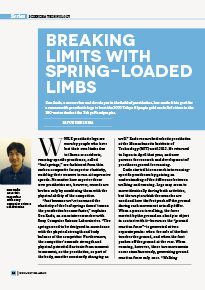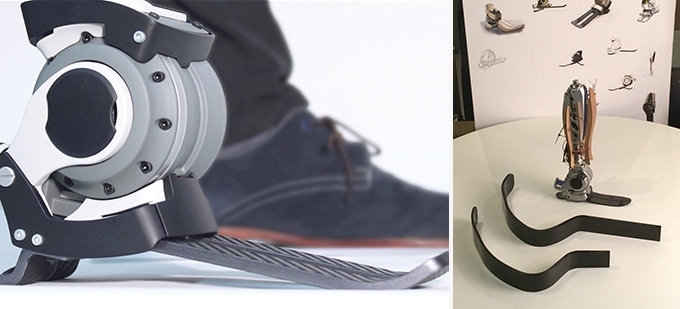Home > Highlighting JAPAN >Highlighting Japan October 2015>Science & Technology
Highlighting JAPAN

Science & Technology
Breaking
Limits with Spring-Loaded Limbs
Ken Endo, a researcher and developer in the field of prosthetics, has made it his goal for a runner with prosthetic legs to beat the 2020 Tokyo Olympic gold medalist’s time in the 100-meter dash at the Tokyo Paralympics.

While prosthetic legs are worn by people who have lost their own limbs due to illness or accidents, running-specific prostheses, called “leaf springs,” are fashioned from thin carbon composite for superior elasticity, enabling their wearers to run at impressive speeds. No matter how superior these new prosthetics are, however, records are broken only by combining them with the physical ability of the competitor.
“Just because we’ve increased the elasticity of the leaf springs doesn’t mean the prosthetics become faster,” explains Ken Endo, an associate researcher with Sony Computer Science Laboratories. “The springs need to be designed in accordance with the physical strength and body balance of the competitor. Furthermore, the competitor’s muscle strength and physical potential fluctuate from moment to moment, so the prosthetics, as part of the body, must be constantly changing as well.” Endo researched robotic prosthetics at the Massachusetts Institute of Technology (MIT) until 2012. He returned to Japan in April that year, and now pursues the research and development of prostheses geared for running.
Endo started his research into running-specific prostheses by gaining an understanding of the difference between walking and running. Legs may seem to move identically during both activities, but the way in which the muscles are used and how the feet push off the ground during each movement actually differ. When a person is walking, the force exerted by the ground on a body or object in contact with it—known as the “ground reaction force”—is generated at two separate peaks: when the sole of the foot touches the ground, and when the foot pushes off the ground at the rear. When running, however, these two movements occur simultaneously, generating ground reaction force only once. “Walking and running are so different that they could be considered completely different movements,” Endo observes.
The robotic prosthetics Endo has been researching since his MIT days are designed with walking, standing, sitting and climbing stairs in mind; their purpose is to make everyday life more comfortable. The motors installed in the knees and ankles offer support for leg movement, and can be adjusted via software to provide more complex movement. Running-specific prostheses, on the other hand, are designed with the physical strength of the competitor in mind, and therefore must be custom-made for each athlete. At the same time, competitors must learn how to run and position their torsos in a manner compatible with the springs of their prosthetics.
Initially, Endo wasn’t familiar with the ins and outs of track and field, but soon became acquainted with former track and field Olympian Dai Tamesue. In May 2014, while continuing to conduct primary research at his current lab, he founded Xiborg, a company promoting the development and use of prosthetic legs. Xiborg has contracts with three of Japan’s top track and field athletes with physical disabilities. At regular practice sessions, Endo and Tamesue meet with prosthetists as well as other athletes to discuss and fine-tune the development of Xiborg’s prosthetics. Although just a little over a year has passed since Xiborg was founded, its associated athletes have continued to gradually improve on their personal records.
“First we are aiming for a Paralympian fitted with prosthetics we created to compete at the 2016 Paralympics in Rio,” Endo says. “Then, at the 2020 Tokyo Paralympics, our goal will be to beat the Olympic winner’s time in the 100-meter sprint.”
The goal is not limited to just the world record, however. By opening up the development of Xiborg’s prosthetics to the public, he wants to spotlight the conditions of the physically disabled and the tenacity of Paralympians. “I think it’s amazing that people with amputated limbs who were previously unable to walk are now able to run this quickly when equipped with prosthetics,” Endo declares. “I’d like to be able to help these people contribute to society through sports.”
© 2009 Cabinet Office, Government of Japan






